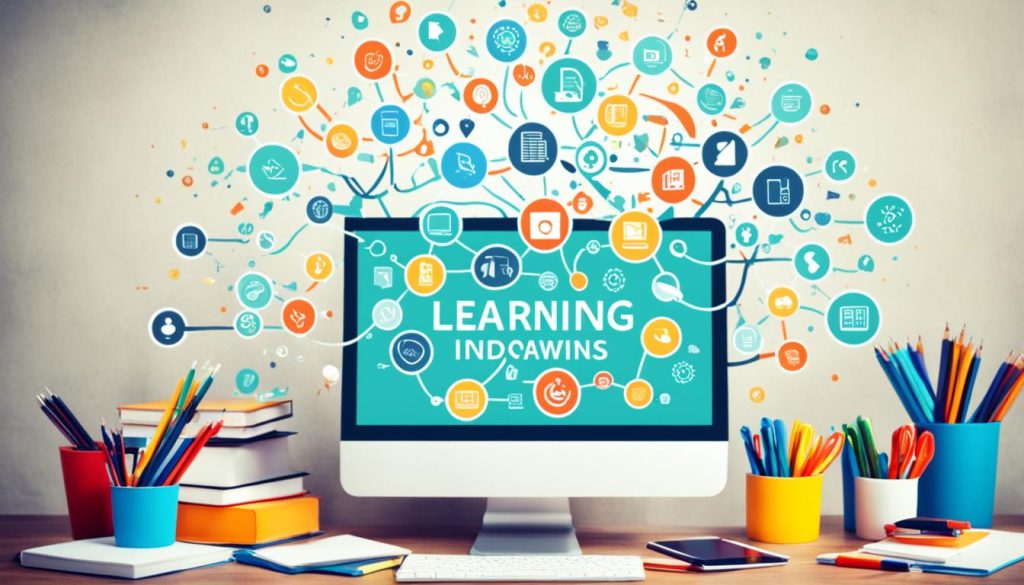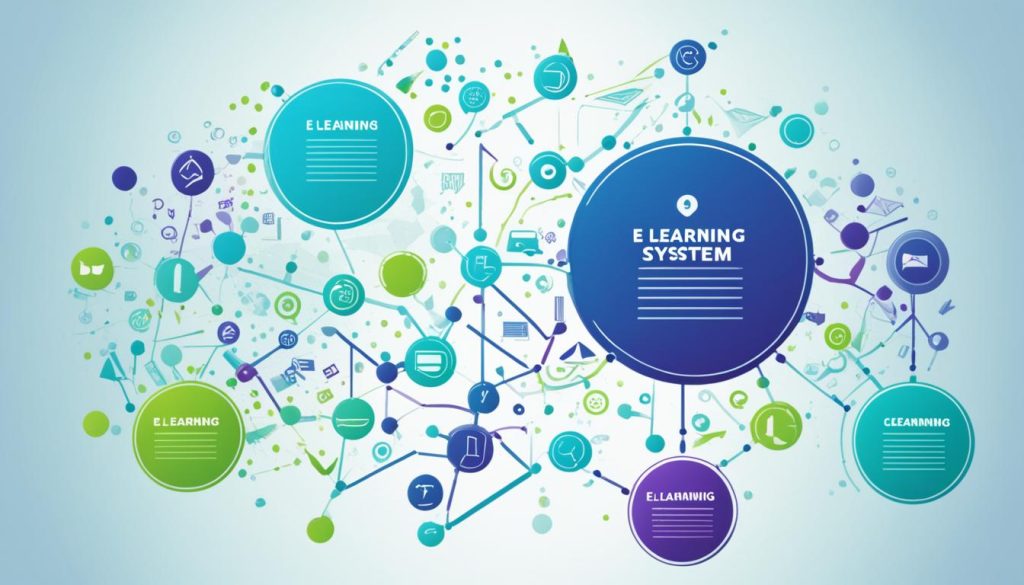E-learning platforms have transformed the educational landscape, offering accessibility and flexibility to learners around the world. The demand for these platforms has skyrocketed, with the global e-learning market projected to exceed USD 30 billion by 2022. At [Your Company Name], we specialize in crafting cutting-edge solutions for e-learning platform development, catering to the evolving needs of educational institutions and learners alike.
Our team of experienced developers and instructional designers understands the unique challenges faced by the education sector. We believe that effective e-learning platforms should be customizable, user-friendly, and empower learners to achieve their academic goals. Utilizing the latest technologies and best practices, we create innovative solutions that transform traditional educational approaches into engaging and interactive experiences.
Key Takeaways:
- Customized e-learning platforms enhance the learning experience for educators and learners.
- E-learning platforms provide accessibility, flexibility, and personalized learning experiences.
- The global e-learning market is projected to exceed USD 30 billion by 2022.
- At [Your Company Name], we specialize in crafting innovative solutions for e-learning platform development.
- Our team ensures that our platforms are user-friendly and aligned with the specific needs of educational institutions.
The E-Learning Revolution
E-learning platforms have revolutionized the field of education, providing accessibility, flexibility, and personalized learning experiences. These platforms have become an essential component of modern education, offering numerous benefits for both educational institutions and learners. Let’s explore the key features that make e-learning platforms so impactful.
Accessibility and Flexibility
E-learning platforms break down geographical barriers, allowing learners to access educational content from anywhere in the world. With just an internet connection, students can study at their own pace, fitting their learning around their schedule. This accessibility and flexibility enable individuals to pursue education while balancing other commitments like work or family.
Personalization
E-learning platforms offer personalized learning experiences, catering to the unique needs and goals of individual learners. Through adaptive learning paths and intelligent algorithms, these platforms track learners’ progress and suggest personalized content and resources. This tailored approach enhances engagement and ensures that students receive the most relevant educational materials.
Diverse Content
E-learning platforms provide a wealth of diverse content, covering various subjects and topics. Learners can explore a wide range of courses and resources, enabling them to pursue their interests and broaden their knowledge. From academic subjects to professional development courses, e-learning platforms offer a comprehensive library of educational materials.
Cost-Effectiveness
E-learning platforms offer cost-effective solutions for both educational institutions and learners. For educational institutions, implementing e-learning platforms can significantly reduce costs associated with physical infrastructure, travel expenses, and printed learning materials. Students also benefit from reduced costs as online courses tend to have lower tuition fees compared to traditional classrooms.
As e-learning platforms continue to evolve and improve, they play a crucial role in transforming education. With their accessibility, flexibility, personalization, diverse content, and cost-effectiveness, these platforms provide innovative and effective learning solutions for individuals and institutions alike.
| Benefits of E-Learning Platforms | Description |
|---|---|
| Accessibility | Breaks down geographical barriers, allowing learners to access educational content from anywhere. |
| Flexibility | Enables learners to study at their own pace, fitting their education around their schedule. |
| Personalization | Provides tailored learning experiences based on individual needs and goals. |
| Diverse Content | Offers a wide range of subjects and topics to cater to different interests and knowledge areas. |
| Cost-Effectiveness | Reduces costs for educational institutions and students, making education more affordable. |
How the Custom E-Learning Solutions Empower the Greater Learning Curve
Customization is a key advantage of e-learning platforms. These platforms enable the creation of tailored content that aligns with learners’ specific goals and needs. By providing personalized learning experiences, **creating e-learning platforms** empower learners to embark on a more productive and engaging learning journey.
One of the ways e-learning platforms achieve this is through adaptive learning paths. With the help of algorithms and AI, these platforms track learners’ progress and dynamically adjust the learning path accordingly. This personalized approach ensures that each learner receives the content and resources they require, enhancing their proficiency and understanding.
Furthermore, multi-purpose learning platforms cater to various educational institutions, from schools and colleges to corporate training programs. These platforms offer the flexibility to adapt to different learning environments and deliver targeted educational materials as per the unique requirements of each organization.
Personalized feedback and assessment mechanisms are also critical components of custom e-learning solutions. By providing immediate feedback and ongoing evaluations, learners can gain a deeper understanding of their strengths and areas for improvement. This feedback loop motivates learners to invest further in their education and drives better learning outcomes.
To make the learning experience engaging and enjoyable, e-learning platforms incorporate gamification elements. Gamification techniques, such as badges, leaderboards, and rewards, incentivize learners and create a sense of accomplishment. These elements not only make learning more fun but also foster healthy competition among learners, promoting a positive learning environment.
Lastly, e-learning platforms prioritize the integrity and security of the learning environment. They incorporate robust security features to protect against data breaches and ensure that the platform remains a safe space for learners. This commitment to security instills confidence in both learners and educational institutions, encouraging increased adoption of e-learning solutions.

Step by Step E-learning System Development Process
Creating a customized and efficient e-learning platform requires a systematic development process. By following a step-by-step approach, organizations can ensure the successful implementation of their e-learning initiatives. Let’s explore the key stages involved in the development of e-learning platforms:
1. Project Assessment
Before embarking on the development journey, it is crucial to assess the organization’s specific requirements and objectives. This involves understanding the target audience, identifying learning goals, and evaluating the existing infrastructure. By conducting a comprehensive project assessment, developers can lay a solid foundation for building an effective e-learning platform.
2. Content Creation and Strategization
The success of an e-learning platform hinges on engaging and relevant content. During this stage, instructional designers and subject matter experts work collaboratively to develop instructional materials, multimedia content, and assessments. Additionally, strategizing the content delivery approach, such as microlearning modules or video-based lessons, helps optimize the learning experience for users.
3. Platform Development
With the content prepared, it’s time to dive into platform development. This stage involves creating the foundational structure of the e-learning platform, including user authentication, content organization, and learner tracking capabilities. Collaborative features, such as discussion forums and chat functionalities, may also be integrated to facilitate interaction among learners and instructors.
4. User Experience (UX) Design
The user experience plays a pivotal role in the success of an e-learning platform. UX designers focus on creating intuitive and visually appealing interfaces that enhance usability and navigation. They conduct user research, wireframing, prototyping, and iterative testing to ensure that the platform delivers a seamless learning experience across various devices.
5. E-learning Solution Development
During this stage, developers work on incorporating specific e-learning solutions, such as learning management system (LMS) integration, interactive assessments, and progress tracking. These solutions enhance the platform’s functionality and provide a comprehensive learning ecosystem for users.
6. Integrating Solutions
To further enrich the e-learning experience, it is essential to integrate additional solutions such as video conferencing tools, virtual reality (VR) simulations, or learning analytics systems. These integrations expand the capabilities of the platform, allowing for more interactive and immersive learning experiences.
7. Feedback and Improvisations
No e-learning platform is complete without soliciting feedback from users and stakeholders. This stage involves gathering feedback through surveys, user testing, and analytics, enabling developers to identify areas for improvement. Based on the feedback received, iterative enhancements and updates are made to refine and optimize the platform.

By following this step-by-step e-learning system development process, organizations can ensure the creation of a customized and efficient e-learning platform that effectively meets their specific needs. The key is to prioritize user experience, engagement, and continuous improvement throughout the development process.
Conclusion
E-learning platform development plays a crucial role in delivering innovative and effective learning solutions. By harnessing the power of customization and versatility, these platforms have the ability to enhance the learning experience for both educators and learners. With the growing demand for e-learning solutions, it has become imperative for organizations to invest in building high-quality and user-friendly platforms that cater to diverse educational needs.
Partnering with experienced e-learning development companies like Amplework can ensure the successful creation of customized e-learning platforms. Their expertise in e-learning platform building allows them to design and develop tailored solutions that meet the specific requirements of educational institutions, corporations, and other organizations.
By leveraging the latest technologies and incorporating interactive features, these platforms enable learners to engage with the content effectively. Furthermore, they provide educators with the tools and resources necessary to create engaging and immersive learning experiences.
Investing in e-learning platform development not only leads to enhanced learning outcomes but also provides organizations with a competitive edge in the rapidly evolving digital landscape. With the right partner, organizations can unlock the full potential of e-learning and empower learners to thrive in a knowledge-driven world.




No comments! Be the first commenter?